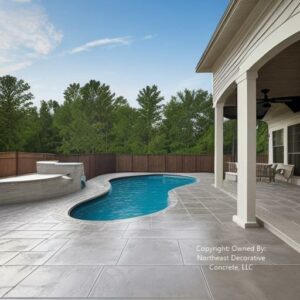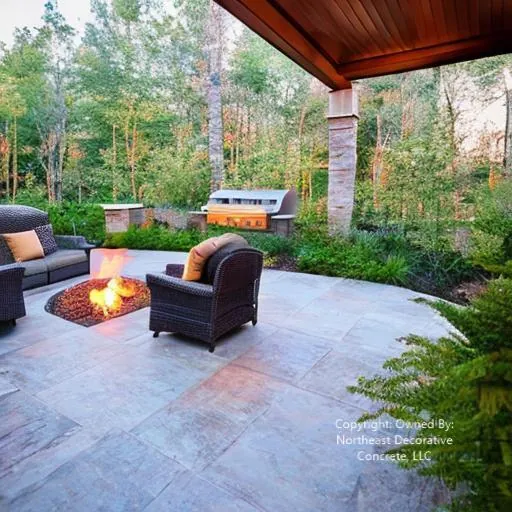
Which Is Cheaper Flagstone Or Stamped Concrete?
I’ve helped countless homeowners install beautiful patios. We used materials like flagstone and stamped concrete. When deciding between these two options, I’m often asked: “Which patio material is cheaper?” The answer is more than just comparing the upfront costs per square foot. I look at the whole lifetime value. This includes factors like durability, maintenance, and aesthetics.
I can guide clients to the best long-term patio solution to fit their budget by evaluating all these aspects. But stamped concrete is much cheaper at $10 to $20 sq. ft. and, on average, $15 to install vs. $15 to $27 sq. ft. for natural flagstone with an average of $21 installed. Stone must be imported nationally to many areas without native quarries, increasing costs. Concrete stamping uses local materials for the raw ingredients, keeping pricing consistent across regions. That is why colored concrete is 33-percent cheaper.
| Metric | Value |
|---|---|
| Stamping | $15 |
| F-Stone | $21 |
| Absolute Difference | $6 |
| Combined Average Price | $18 |
| Percentage Difference | 33% |
A Breakdown of Natural Stone and Stamped Concrete
Before comparing patio prices, it’s essential to understand what a stepping stone and stamped concrete are.
Natural stone refers to quarried stone slabs. It is used for patios, walkways, walls, and other hardscaping projects. The stone comes in irregular sizes and shapes. They get arranged individually like a puzzle. Common types of stone include bluestone, sandstone, and slate.
Stamped concrete involves pouring concrete. Realistic patterns are imprinted into the surface while it’s still wet. The stamps can mimic brick, cobblestone, stone, wood planking, and more. Concrete is very versatile and available in endless design combinations.
Both materials create elegant patios. But, they achieve their beauty through very different means. Keep reading as I break down their cost differences and other important considerations.
Natural Stone Patio Cost Breakdown
Constructing a stone patio entails sourcing the stone slabs. Then, you transport them to your home. Finally, you manually fit each piece together.
Here’s a closer look at typical stone patio costs:
-
Paving stone material – $800-$2000 for enough coverage for a 10×10 patio
-
Cost depends on the type and quality of stone
-
-
Base preparation – $600-$1000
-
Excavating, leveling, and installing crushed stone base
-
-
Installation labor – $10-$15 per sq. ft.
-
Placing irregular stones is labor-intensive
-
-
Other costs – delivery fees, permits, sealing
In total, expect to spend around $15 to $27 per sq. ft. for a professionally installed flag paver patio. Prices can go higher or lower depending on your location. Patio size and design complexity also impact prices. Larger patios tend to be slightly cheaper per sq. ft. due to cost efficiencies.
Stamped Concrete Patio Cost Breakdown
Stamped concrete patios and driveways get poured and molded on-site. This avoids the materials transport costs of natural pavers.
Here are typical concrete stamping patio expenses:
-
Concrete materials – $3-$4 per sq. ft.
-
Concrete itself is relatively inexpensive.
-
-
Stamping tools & color treatments – $2-$3 per sq. ft.
-
Special tools and dyes are used to achieve the desired finishes.
-
-
Installation labor – $5-$13 per sq. ft.
-
Requires proper pouring and stamping techniques.
-
-
Other costs – permits, sealing, potential demolition
Concrete stamped patios often range from $10-$20 per sq. ft. installed locally. Simple designs can cost less.

Key Cost Considerations Beyond Sq. Ft. Pricing
When advising clients on choosing a patio material, I emphasize looking past the base bids and square footage rates. Several other factors also impact the overall price:
Material Quality
-
Higher-end paving stone types can increase the cost
-
Unique concrete mix designs affect pricing
Permits & Site Preparation
-
Local codes may require specific base builds
-
Demolition and removal expenses if replacing the old patio
Design Complexity
-
Custom stamps, patterns, and finishes add labor and materials costs
-
Intricate stone layouts take more time
Project Size
-
Bigger jobs achieve more pricing efficiency
-
Small projects are limited in material choice
I always tell customers: “Get at least three quotes before deciding.” This gives you an accurate picture of costs. It’s based on your specific project parameters.
Flagstone Patio Paver Offers a Natural, Timeless Look
Regarding patio aesthetics, a natural stone paver brings a sense of earthy, rustic beauty. The irregular sizes and shapes of the stone slabs create free-flowing organic patterns. The colors range from cool-toned grays and blues to warm tans and browns. This depends on your chosen material, such as bluestone, sandstone, or slate. Cobblestone’s natural elegance and charm have remained popular for centuries. It fits nicely into landscapes aiming for a relaxed, pastoral vibe. The stone can also stand alone as a focal point.
Some key benefits of flag paving stones aesthetics:
-
Long-lasting, classic appeal
-
Distinctive, irregular textures
-
It feels cozy and inviting
-
Blends with natural surroundings
Stamped Concrete Boasts Endless Customization
For customers wanting more design flexibility, you can’t beat stamped concrete. Paver stone relies on the stone’s natural beauty. Meanwhile, stamped concrete gets patterned and colored as you wish. You can choose from hundreds of mold patterns. They mimic looks from rustic cobblestone to modern wood planking and more. Stamping techniques like chiseling and distressing further enhance the realistic appearances. Custom integrally colored concrete comes in a wide selection. Specialty finishes open even more possibilities.
Some notable benefits of stamped concrete include:
-
Mimics virtually any paver material
-
Choose from endless combinations
-
Achieve one-of-a-kind designs
-
Integrate special logos and details
With stamped concrete, the only limit is your imagination!
Pros and Cons: Stamped Concrete Vs. Natural Pavers
Lifespan and performance should play a pivotal role when weighing patio materials. First, let’s examine how durable paver stone is:
Stone Strengths
-
long-lasting; stands up to elements
-
Can last 50+ years before replacement is needed
-
Resists cracking; flexible to shift
Potential Stone Issues
-
Sealing is required every 3-5 years
-
Minor erosion can occur over time
-
Stains if spills aren’t cleaned promptly
Now let’s see how stamped concrete compares:
Stamped Concrete Strengths
-
Inherent strength of concrete as base material
-
Properly mixed and installed concrete is highly durable
-
Stands up to heavy usage
-
Can last 25+ years before replacement is needed
Potential Stamped Concrete Issues
-
Cracks can form if the base shifts or freezes
-
Frequent sealing needed (every 3-5 years)
-
Hot tire pickup is possible without final protective clear coatings
Both materials can last decades if properly maintained. Stone’s natural strength gives it a slight edge. Stamped concrete offers outstanding longevity with proper installation and care.

Stone Pavers Installation Involves Meticulous Stone Placement
I can confirm that installing driveway stone requires master-level craftsmanship. I speak from my years of experience. Each irregularly sized stone gets individually cut and fitted together like a puzzle. This forms a seamless patio surface. This is physically demanding work. Achieving clean lines and smooth transitions between stones requires care and precision. The prep work is also labor-intensive. It involves excavating, grading, compacting aggregate base materials, and leveling. This is all required before the first stone gets set.
Some key driveway stone installation factors:
-
Puzzle-like stone placement
-
Intensive hand selection of pieces
-
Experience needed for pleasing layouts
-
Physically taxing work
-
Multi-step base preparation
Stamped Concrete Demands Meticulous Workmanship As Well
Installing pool deck stone takes finesse. Perfectly stamped and colored concrete also requires skillful installation.
The process includes:
-
Pouring and smoothing concrete to proper depths & slopes
-
Methodically imprinting textures while concrete is pliable
-
Applying specialty color treatments and finishes
-
Curing and sealing properly
The finished product directly shows the quality and care put into every step. One sloppy mistake can ruin the entire patio!
Some keys for flawless stamped concrete:
-
Careful base prep and concrete pouring
-
Meticulously pressing stamps/molds
-
Artistry with coloring for realistic looks
-
Following ideal curing and sealing steps
How Should This Comparison Inform Your Paver Patio Decision?
As you can see from my detailed overview, stone and stamped concrete slabs are both excellent patio building materials. Proper installation is a must. But they achieve their beauty and functionality in very different ways.
Homeowners should consider the following factors when deciding between stone pavers and stamped concrete:
-
Cost – Obtain multiple quotes. Compare base bids plus long-term expenses.
-
Aesthetics – Choose the look that best fits your vision.
-
Durability – Understand maintenance needs for lasting quality.
-
Installation – Hire contractors experienced with each respective material.
Remember, I’m a concrete contractor with real-world expertise. I’m always happy to discuss your project and provide recommendations. If you have any other questions not answered here, ask me!
Our Locations:
Nashua, NH
North Hampton, NH
Concord, NH

